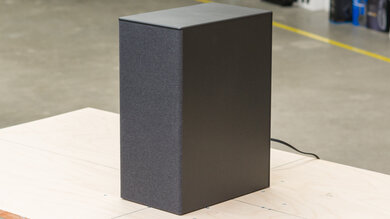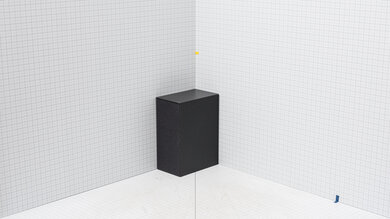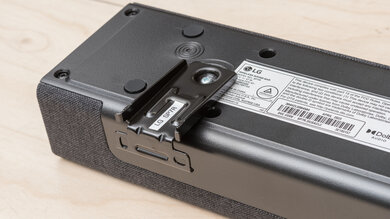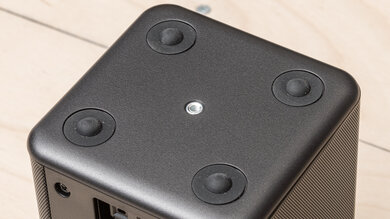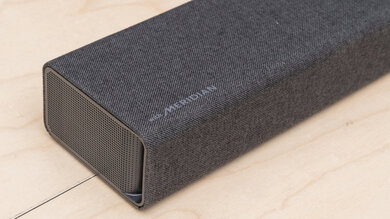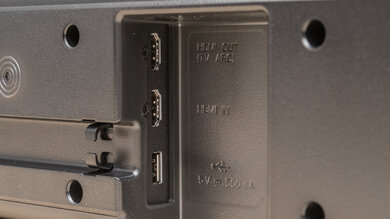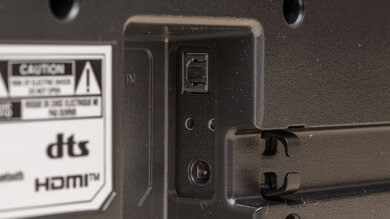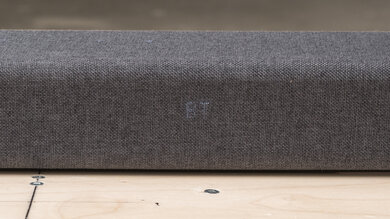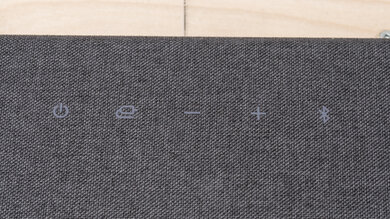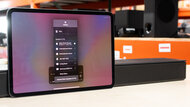The LG SP7R is a mid-range option from this manufacturer that includes rear speakers for improved surround sound. It's a Bluetooth-compatible soundbar with lots of different sound modes, like Clear Voice and Bass Blast. It also supports the manufacturer's TV Sound Mode Share feature, so you can pair it up to a compatible LG TV for a more immersive sound. However, it can't playback more advanced formats like Dolby Atmos.
Our Verdict
The LG SP7R 7.1 is decent for mixed usage. This 7.1 setup is an affordable alternative to other options on the market. The inclusion of rear speakers brings a more clear and real feel to 5.1 surround sound formats like Dolby Digital, which are commonly found on streaming platforms and Blu-rays. However, the bar doesn't implement these formats properly, which takes away from the overall immersive feel. It lacks more premium features like Atmos support, too.
- Bass and treble adjustments.
- Rear speakers included.
- No room correction.
- No Dolby Atmos support.
The LG SP7R is good for dialogue-centric TV shows and podcasts. This 7.1 setup has a discrete center channel to improve vocal clarity in the mix. With a fairly even sound, it reproduces voices with clarity and detail. You can even use its dialogue enhancement tool to make voices more accurate. Also, it's easy to stream podcasts to the bar via Bluetooth.
- Dialogue enhancement tool.
- Bluetooth compatible.
- No room correction.
The LG SP7R is decent for music. Out-of-the-box, this soundbar has a fairly even sound, resulting in a clear reproduction of voices and instruments in the mix. The sub also brings out some punch in the bass, though it doesn't have as impressive a low-frequency extension as other models. You can customize its sound a bit with bass and treble adjustments, though it lacks more premium features like room correction.
- Bass and treble adjustments.
- No room correction.
The LG SP7R is fair for movies. This setup comes with rear speakers to improve the listening experience with multi-channel content like Dolby Digital and DTS. However, it doesn't implement these formats properly, resulting in a slightly less life-like listening experience. It doesn't support height content like Dolby Atmos, which is more and more common on different streaming platforms.
- Rear speakers included.
- Dialogue enhancement tool.
- No room correction.
- No Dolby Atmos support.
Check Price
Differences Between Sizes And Variants
The LG SP7R 7.1 is available in Black, and you can see the label for our tested model here.
If you come across another version of this soundbar, let us know in the forums.
Popular Soundbar Comparisons
The LG SP7R 7.1 offers similar performance to models like the LG SP7Y, but the added rear speakers improve its surround sound. However, it lacks up-firing speakers, so it can't playback Dolby Atmos content like more premium bars from the manufacturer, like the LG S75QR. It's a pretty simple bar overall, and you won't find more advanced sound customization tools like room correction, either.
See also our recommendations for the best soundbars, the best LG soundbars, and the best soundbars for music.
The LG SP7R is better than the LG SP7Y for most uses. The SP7R comes with rear speakers designed to bring a clearer and more life-like feel to multichannel content like Dolby Digital. As a result, it's better for surround sound. However, the bar can't implement these formats properly like the LG SP7Y, so effects meant for the right and left surrounds play on the rears instead.
Depending on your listening habits, you may prefer either the LG SPD7Y or the LG SP7R. The main difference between these two setups is that the SP7R has rear speakers, while the SPD7Y doesn't. This means that the SP7R has a better surround sound performance. However, it doesn't support Dolby Atmos content like the SPD7Y.
The Vizio M Series M512a-H6 is better than the LG SP7R. The Vizio supports Dolby Atmos content, unlike the LG. It gets louder, too, and reproduces a more extended low-bass. You don't have to wire its satellites to a receiver, which some users may prefer.
The LG S75QR is better than the LG SP7R. The main difference between the two bars comes from Dolby Atmos support. While the SP7R doesn't support Atmos, the S75QR does. Additionally, the S75QR can correctly implement surround sound formats like Dolby Digital and DTS for a more immersive feel.
Test Results

It's roughly the same size as the sub that comes with the LG S75QR. It connects wirelessly to the bar.
The satellites are the same size as those that come with the LG S75QR. You have to wire them to the receiver, which limits where you can put them in your space.
The LG SP7R has a good build quality. The bar itself is mostly made of plastic, and tight fabric covers the speakers. The manufacturer says the fabric is made of recycled plastic bottles; it feels well-knit and decent to touch. The same fabric covers the front of the sub. The rest of the sub and the satellites are made of plastic, which feels solid. However, the plastic for the receiver feels a little on the cheaper side.
The LG SP7R has a decent stereo frequency response. Vocals and lead instruments sound clear, although a dip in the treble veils their detail a bit. The bar doesn't bring as much rumble in the low-bass as more premium models, but you still get decent punch in the mix.
If you want a more neutral sound with stereo content, set the bass to -4 and the treble to 2. The resulting sound follows our target curve more closely, and vocals and instruments sound brighter with a little extra emphasis in the treble.
The LG SP7R has a decent stereo soundstage. The width of the soundstage seems to stretch a little past the edges of the bar itself, but it doesn't go much further than that. Focus is decent, but some effects aren't as accurately placed to a pinpoint location in the soundstage.
The bar gets loud enough to fill an average-sized living room with sound. That said, compared to other models like the LG S75QR, it isn't quite as suitable for larger and more open rooms. Still, compression is minimal as you push it to max volume.
Distortion falls within good limits when you listen at an average volume. Cranking the bar to max volume causes a jump in distortion, especially in the bass range, though this is hard to hear with real-life content.
This 7.1 setup has a discrete center channel to improve vocal clarity in the mix. However, its frequency response is a little uneven, especially in the high-bass to low-mids. This dip thins out voices and makes them lack depth and body, so they sound a little flat but also bright due to the peak in the treble. Still, voices are clear and detailed, so they're easy to follow.
Thanks to its rear speakers, this soundbar offers a good surround performance. You get a more clear and real feel with your audio, as sound effects stretch into the space around your living room. That said, the frequency response on these channels is a bit uneven, resulting in a dark sound that makes some effects, like the coins in the Ready Player One (2018) race scene, less than clear. The lack of low-bass is evident in action-packed scenes, too, as you don't get a deep rumble in the bass.
The LG SP7R 7.1 has a pretty standard selection of sound enhancement features. You won't find a room correction tool like with more premium bars, but you can make up for differences in the sound a bit with its bass and treble adjustments. There are lots of EQ presets on hand, too, including 'AI Sound Pro', 'Standard', 'Bass Blast', 'Music', 'Clear Voice', 'Game', 'Cinema', 'DTS Virtual:X', and 'Sports'. 'Clear Voice' enhances dialogue in movies and TV shows.
You can connect the bar to your TV over Optical or HDMI. Since it has a Full HDMI In port, you can use the bar as a hub between devices like a TV and a PC. There's also a USB port for audio playback.
The LG SP7R 7.1 supports some common surround sound formats like Dolby Digital and DTS. However, it plays sound meant for the left and right surround channels through the rear speakers instead. As a result, sound effects aren't quite as accurately localized in the space around you, so you don't get as life-like of a listening experience. Unfortunately, the bar doesn't support lossless and object-based formats like Dolby Atmos.
The bar performs similarly over HDMI In. It can playback Dolby Digital and DTS content, but audio intended for the right and left surrounds plays from the right and left rear speakers instead. It can't playback PCM content clearly, either. In our tests, we found that some channels played static noise while others were muffled.
The same implementation issue is present over Optical. The bar can playback Dolby Digital and DTS content, though audio meant for the left and right surround channels plays from the rear speakers instead. As a result, sound effects aren't as accurately localized in the room around you, so you don't get as life-like of a feel.
The LG SP7R 7.1 has middling latency. While it falls within good limits over Full HDMI In, latency is on the higher end over ARC and Optical connections. As a result, you notice some delay between the audio you hear and the visuals on your screen. Fortunately, the AV Sync feature in the LG Sound Bar app lets you adjust for any delay manually. Some apps and TVs compensate for latency differently, too.
This soundbar can only passthrough some common resolutions and refresh rates. According to the Murideo device, the bar is capable of 1080p passthrough at 60Hz. However, when we connected the bar to a PC and a Blu-ray player, it could only passthrough 480p at 60Hz, so your real-world experience may be a little worse than what our results show if you can't enjoy the clearer 1080p resolution. Let us know in the forums if you experience similar issues with this bar.
You can wirelessly stream audio to the bar via Bluetooth.


